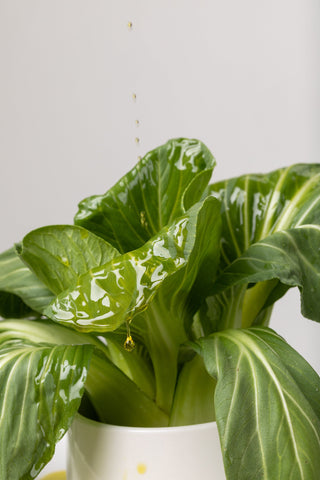Master your Vinaigrette
How do I make a vinaigrette?
Our most frequently asked question…
Being a shop specializing in various oils and vinegar, we get asked *a lot* about crafting vinaigrettes. These questions range from ‘How do I make a vinaigrette?’ to ‘which combination of oil and vinegar makes the best vinaigrette?’.
Our answer… The best vinaigrettes are based on seasonality and the freshest, highest-quality ingredients.
Fat, Acid, and Seasoning
The three main elements behind a great vinaigrette are fat, acid, and seasoning. The fat, or oil, coats the salad and distributes flavor. The acid, or vinegar, balances the oil while providing brightness. Finally, the seasonings build upon the two other elements, highlighting the individual salad ingredients and imparting flavor and depth. The best method of deploying seasoning to a vinaigrette is to taste as you go.

Drizzled, Spiced, and…Massaged
Now that our elements are covered, it’s time to get into the seasonal specifics. Fall fruits, vegetables, herbs, and leafy greens tend to be on the heartier side, and require a little more vinaigrette TLC.
Drizzled
 Early fall fruits and vegetables will be more delicate than their later in the season counterparts. This is especially true for early fall leafy greens.
Early fall fruits and vegetables will be more delicate than their later in the season counterparts. This is especially true for early fall leafy greens. These will be the ‘baby’ green varieties of kale, chard, spinach, arugula, etc… If we add oodles of acidity to our vinaigrette, these greens will begin to break down and wilt. We also don’t want to make a vinaigrette that requires a lot of tossing, damaging these greens further.
So, we’re looking for a drizzled vinaigrette. A vinaigrette that will coat (more oil) without damaging (less vinegar), as well as impart flavor (seasonings abound). The 3:1 vinaigrette (3 parts oil to 1 part vinegar) is one of the most widely used vinaigrette ratios (since most of the year we’re using tender greens as our salad base) and perfect for our early fall salads.
Spiced

Fall is about flavor! Savory spices, baking spices, earthy spices, roasting spices, spicy spices…you name it, traditional fall dishes have flavor in spades. However, what makes this season even more of a flavor boom is the versatility of its ingredients. Root vegetables, hearty squashes, and earthy grains (all abundant in the fall) are culinary chameleons, incredibly delicious ingredients that can be made sweet, savory, or spicy.
When crafting a vinaigrette for these deliciously adaptable fall ingredients, we like to feature our more robustly flavored oils, vinegar, and seasonings. The 2:1 vinaigrette (2 parts flavored oil to 1 part flavored vinegar) creates balance. A spicier oil can be balanced with a sweet-fruity vinegar; a citrusy vinegar can balance an herbaceous oil and vice versa.
Massaged
This vinaigrette style is used explicitly for those heartier, leafy greens (like kale, collards, cabbage, chard, and mustard) later in the season.
With these raw, super fibrous greens, we need a more acidic vinaigrette to help tenderize (and make these veggies easier to digest). We also need to work the vinaigrette into the leaves to help expedite the tenderizing process and infuse the greens with flavor. So when you’re craving a fibrous fall salad, that’s when you roll up your sleeves and give your salad greens a nice massage. The 1:1 vinaigrette ratio (1 part oil to 1 part vinegar) ensures that we’re infusing enough acid into the greens to soften. To balance that extra acidity, we recommend topping massaged salads with more decadent ingredients. Ingredients like creamy cheeses, hearty grains, nuts, seeds, and sweeter fresh or dried fruits. 